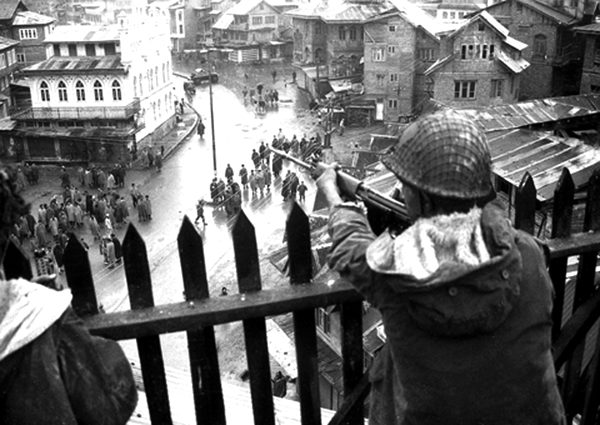By : Umar Manzoor
The world even today continues to remain in a fix over the resilience the Kashmiri people exhibit and how they keep the resistance alive amid constant fear and clampdowns. The world is yet to understand how people of Kashmir survive for months of curfews and restrictions. How could killings instigate more protests and why is there not even a single sign of regret in their behaviour. If one perceives the Gaw Kadal Massacre of January 21, 1990 a mere incident when Kashmiris were killed enmasse just like they are getting killed now-they are wrong. The fact is that the tragedy of Gaw Kadal shaped the Kashmir’s resistance movement to the extent thateven now its glimpses could be felt on ground. It taught people to survive amid curfews, it taught them to use local mosques as central places and raise slogans from the loudspeakers. It taught them how to spend lives amid constant fear and clampdowns. On January 19, 1990, Dr Farooq resigned and Jagmohan came back as JK’s governor. A day after, Srinagar was handed over to CRPF. Large scale arrests in the dead of the night were made with forces barging into peoples’ homes and dragging people particularly youth from their beds and throwing them into torture centres. Curfew was imposed. Kashmir witnessed the large scale protests on Jan 21, 1990. People in droves across Srinagar, defying curfew, took to streets, raising slogans-, demanding immediate release of their dear ones. People from Batamaloo, Barzulla, Ram Bagh, JawaharNagar, Chanapora assembled in Srinagar’s Lal Chowk. The procession started moving towards old city via Budshah Chowk. As it reached near Gaw Kadal, the forces encircled it from all sides and fired in an indiscriminate manner upon people. As bloodbath and mayhem started dominating scenes within moments, people started hurdling dead and injured into local mosques.
Kashmiris did that in 1931 when Maharaja forces fired upon protests outside Srinagar’s central jail. They brought the dead and injured to Jamia Masjid where one injured youth whispered in Shiekh Mohammad Abdullah’s ear, “I have done my bit. It is now you who has the responsibility to take the mission forward.”
According to a foreign news agency that reported the Gaw Kadal massacre, the death toll reached 100 while 50 were admitted in local hospitals. More than 500 arrests were made. Later processions were fired upon at Sonawar, Lal Bazar, Dal Gate, Hawal, Gulab Bagh, Taelbal, Hazaratbal, Nagbal and Ganderbal. The aftermath The reign of terror later was unleashed upon Srinagar. However, people found antidote of this fear. Everyday at dusk they would assemble in mosques and raise slogans to evade arrests. Whenever forces would barge into any area, announcements used to be made on loudspeakers of local mosques- asking people to come out on roads and foil forces’ action. As curfew continued to remain in force, two hours of deal used to be announced by the government everyday. During this time, people would stock essentials in their homes. This was the first time when such scenes were witnessed. The people of Kashmir continue to use the similar methods even today when curfews are imposed in the region. Resistance leader Shakeel Ahamd Bakshi raised ‘Anaaj Ugaw; Aaadi Paav’ slogan. People then started maintaining kitchen gardens in a bid to avoid food paucity.
Sensing situation slipping out of his hands, Governor Jagmohan banned JKLF- a party that enjoyed widespread peoples’ support all across. Besides that Hizb, Peoples’ League, Tehreek-e- Hurriyat, Dukhtaran-e-Milat, Islamic Students League, Jamaet-e-Tulba and Jamat-e-Islami were also declared banned organisations. More than 200 government employees were terminated for taking part in anti-national activities. When Jagmohan appointed his advisors, the name of former state police chief Ghulam Hassan Shah was included in the list. However, Shah rejected the offer and preferred to stay with the people. JKLF launched non-cooperation movement and asked people to boycott every government decision. Wide spread protests dominated entire Kashmir Valley. January 26, 1990 was observed as Black Day by the people. Fearing protests, more rigorous restrictions were imposed across Valley with forces deployment intensified. Several commandos were brought along with additional companies of CRPF. That was the time when school buildings, cinema halls and local hotels were occupied by the forces. In order to foil CRPF attempts to take over Schools, militants set several schools on fire. The curfew passes issued to journalists and government employees weren’t accepted by forces due to which no newspaper was printed from Kashmir for 12 consecutive days. It was during that period that Pakistan sensing opportunity declared that it would take the Kashmir issue to United Nation. Director Doordarshan Lass Koul was killed by militants outside his residence in Bemina. It was after such incident that Doordarshan replaced the word ‘Terrorist’ with word ‘Militant’ in its dailys news bulletins. Dukhtaran-e Milat organised first women protest in Srinagar on February 14, 1990 in which Kashmiri women in thousands took part. Later a memorandum was submitted to Srinagar’s UN office located in Sonawar. On March 11, 1990, Government of India set up a new ministry for Kashmir Affairs. George Fernandes was appointed as its minister. He visited Kashmir several times and tried to contact militants to persuade them so shun the path of violence so that issues could be resolved through dialogue.

